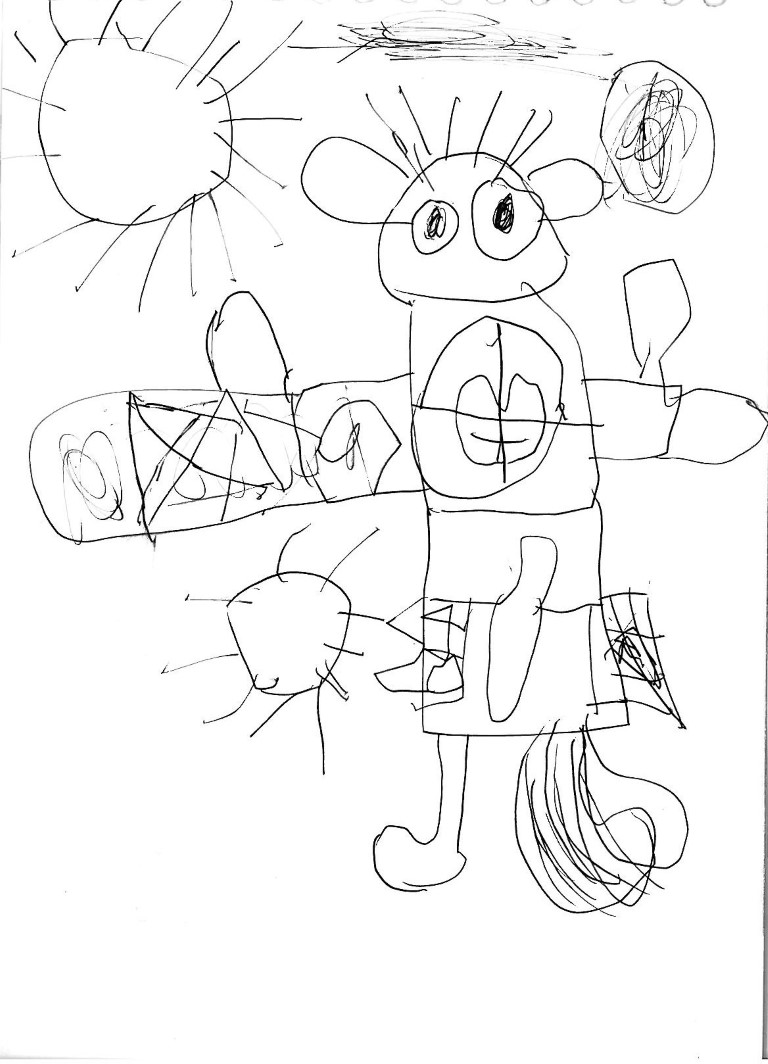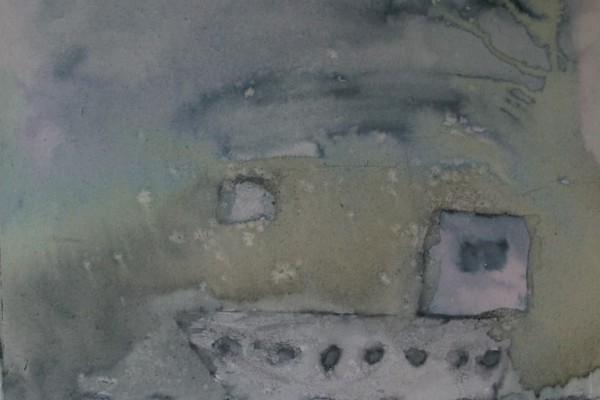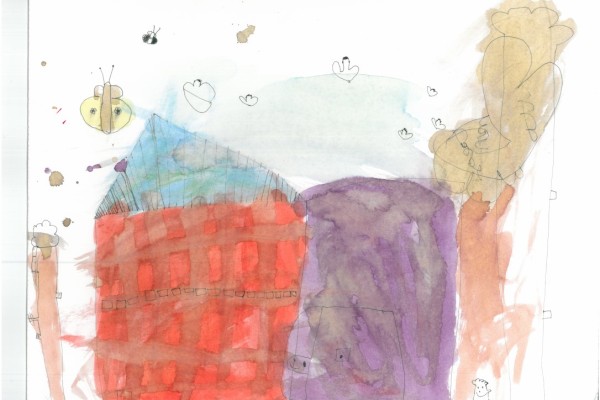Almost all children begin early in life to doodle, and if given the opportunity they will begin to draw. Broad marker or pencil makes an imprint and that is enough to encourage and incite the urge. But many leave it again at a very early age, some as early as when they are 5 or 6. Either because they are preoccupied with other things or because they become critical about how they draw and think that they cannot do it properly.
It is my unscientific conviction that we, when we are little, begin by drawing the perfect doodles, lines and circles, and that we at that point in life can fill out a piece of paper without even thinking about it. The first drawings that resembles a human being has an entirely unique composition and expression, because the child paints without any restriction. And of course many artists work hard though their entire careers to get back to that immediate expression children naturally have in their drawings.
Therefore, if there are any readers who thinks they cannot draw and omits doing it even if they feel just the slightest inclination, I would like to urge you to get out ink and paper, whenever there is an opportunity and just do it. I urge you to do this from a strong conviction, that we are all born with a natural aesthetic sense. This sense will develop naturally, if we are allowed to experiment with different materials and to draw as we want to, alone and in company.
I will dare the argument, that when we as adults are placed in a meeting or talking on the phone and are just mindlessly scribbling with the ballpoint pen, making patterns and shapes, we are in fact reconnecting with the natural aesthetic sense that is to be found in all of us. If you just allow yourself to play with it more often, it will develop into a certain and recognizable style all by itself. It just lies there dormant waiting to be brought to life.
On the same note I do not think that you should try to teach a child how to draw. I think that if you try to you risk that the child loses the urge to draw. Children draw because it is nice, cozy and most importantly because it is a sanctuary where you are not judged, because it is PLAY. Play with color and material, and play is a place of freedom. The most important thing is an adult who also wants to draw and who is completely attentive and occupied with the joint activity.

If the child asks to learn a certain technique it is something else again. Then you can practice together in mastering it. When the child is raised with a natural approach to drawing and to expressing itself in different materials, (he or) she will eventually be able to assess and make up her own mind whether she wants to learn how to draw ‘for real’, read: draw with perspective and naturalistic drawing.
I am greatly inspired by the author, poet, sculptor, anarchist and art critic Herbert Read, who thinks that every civilization should try, not just to preserve the child’s natural sensitivity. He thinks that this sensitivity should be the foundation in the development of the human spirit and that the aesthetic sense, the intuition about what the exact right shapes are, the sense of rhythm and harmony and the urge to create beautiful things, are common and inborn properties in humankind. The urge to create is an inner subjective need and not a copycatting of the adult. When children are imitating what the adult is doing, it is not really to make it look the same way or to do the same thing, but because they want to express themselves in the same language as the adult, to find common grounds. Education should therefore be an attempt to seize this inborn sense of discipline, to help it develop and mature, in contrast to trying to force a disciplinary system upon the child.
Among other things I translate this into the notion that it is strictly forbidden to correct a child when it is drawing or to show it ‘how it is done’. It is deeply offensive to a child if someone draws on his or her drawing without an explicit permission. We all have our obsessions, and this is one of mine – it will make me crawl onto the barricades in the split of a second. To interfere in a child’s creative exploration is a serious matter and it should only be done in mutual agreement respecting each other’s different expressions.
Looking back to 1. grade. I am sitting in my class room and I am being taught by my primary teacher. We are coloring different kinds of animals, and I am using my crayons. When I have finished painting the lion yellow, I get the idea that I want to color beyond the black line to give the lion a golden gleam around the mane. I am brought back from my immersion in the drawing by my teacher who is giving me a thorough scolding saying that I ‘should make an effort to keep my coloring within the lines’ and that I ‘should not soil my books’. Even though I am only six years old I know instinctively that she is wrong, and that I am being treated unfairly. I knew I had done it consciously; I had wanted to test what I could do with the crayons.
Illustration by Birgit (year of 1945). My own urge to draw was nurtured by the complete attentiveness of an adult. I experienced this when my brother and I drew with our mother Birgit. She only ever made one drawing, but we thought it was fantastic. The recipe is very simple. You take a fistful coloring pencils, between 5 and 7 approximately, you cram them in one hand and make a doodle body. It then gets eyes, arms, legs and then together you make up a story about this new little dust bunny doodle and his friends and family.
Many, (many) years later while following classes about art in education, I am introduced to the mantra: “Is it chosen and wanted?”. This is used as a question to investigate and assess if something is of an aesthetic quality beyond the many otherwise fine expressions that randomly occur, when we experiment freely with different materials. We can namely never be absolutely certain if the child is examining new possibilities with a given material or if the child is actually doing something which is both chosen and wanted.
My experience is that if children are inspired by art and the expressions of other people, and if they are given the opportunity to experiment, if they draw and paint with someone who want to do it too, then an interaction takes place where both child and adult can learn from each other. I might have the greater experience about some of the possibilities connected to a certain material, on the other hand the child is unhindered by the limitations of my experience and finds new ways to use the material, and that way new expressions can be explored together.
Illustration by Sol. But to keep the many amazing expressions that often occurs when children paints it is sometimes necessary to be tough and pinch a, in my view, perfect painting and save it from being lost beneath a new piece. The trick to this is to have a new canvas or paper ready and then stick to your action and the injustice of it. My argument is that the possibility to add to the picture still exists. I just need to make a color copy of it first!
And now back to the doodles, which I want to give more than a good cheer. It is an amazing tool to keep you focused during meetings and lectures, where the content has to be intellectually devoured. In itself it is relaxing and without demands, because to doodle means that it really does not have to resemble anything, and children, they always think doodles are really cool, well, because the doodles really rather closely resemble their own drawings!
In my view there is nothing that has as much expression as a doodle. The more you doodle, the more your intrinsic personal style makes itself known, to end in an expression that is unmistakable yours, because in the end it is a reflection of your inner life, both the good stuff and the worse.





















